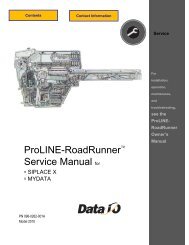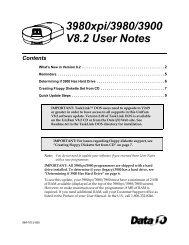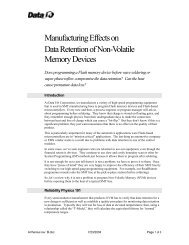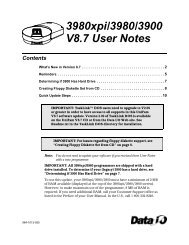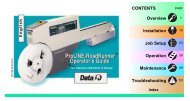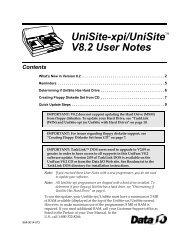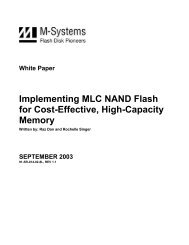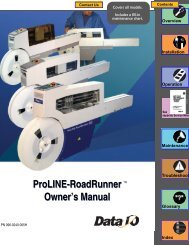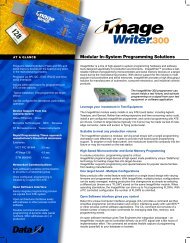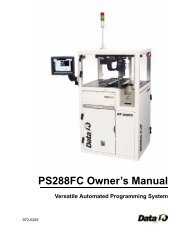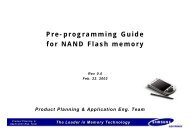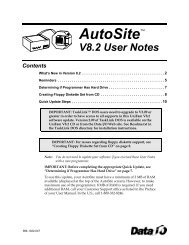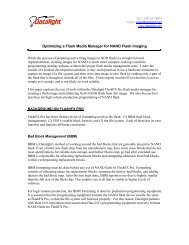3980xpi Users Manual - Data I/O Corporation
3980xpi Users Manual - Data I/O Corporation
3980xpi Users Manual - Data I/O Corporation
You also want an ePaper? Increase the reach of your titles
YUMPU automatically turns print PDFs into web optimized ePapers that Google loves.
Commands<br />
Blank Check<br />
Electronic Erase<br />
Memory Device Illegal Bit Check<br />
More Commands/Device Checks/Illegal Bit Check/<br />
Illegal Bit Check Memory Device<br />
If you selected a memory device, the Illegal Bit Check screen for memory<br />
devices appears. To check a memory device for illegal bits, follow these steps:<br />
1. Select and socket a memory device.<br />
2. Enter the parameters described below.<br />
3. Press ENTER and the programmer begins the Illegal Bit Check. The results<br />
are displayed in the message bar.<br />
The following parameters appear on this screen:<br />
� User <strong>Data</strong> Size<br />
Specifies the size of the data block to check for illegal bits, which is usually<br />
equals the device size or a multiple of device size for checking illegal bits of<br />
a set. Entering 0 resets it to the device size for RAM. User <strong>Data</strong> Size works<br />
with Total Set Size to determine the number of bytes to check in a set.<br />
� Total Set Size<br />
The total number of parts in the set to check for illegal bits.<br />
� <strong>Data</strong> Word Width<br />
Sets the number of bits in the <strong>Data</strong> Word Width. For 8-bit or larger devices,<br />
the minimum word width equals the device width (maximum is 64). For 4bit<br />
devices, the word width choices are 4, 8, 16, and 32, which should<br />
match the data bus word width in the target system for the device.<br />
� Next Device<br />
Type the number next device in the set to check for illegal bits.<br />
� Next Operation Begins At<br />
This field is read-only and cannot be altered. It appears only to inform you<br />
where (at what hex address) the next operation begins.<br />
More Commands/Device Check/Blank Check<br />
The Blank Check command checks a device to ensure that it is blank. To blank<br />
check a device, follow these steps:<br />
1. Select and socket a device.<br />
2. Press ENTER. The programmer checks the device and responds with<br />
OPERATION FAILED: Non-blank device if the device is non-blank, or<br />
OPERATION COMPLETE if the device is blank.<br />
More Commands/Device Check/Electronic Erase<br />
This command bulk erases an electronically erasable device. It is not<br />
necessary to use this command for most electronically erasable devices since<br />
Electronic Erase is part of the normal programming cycle. Before programming<br />
an electronically erasable device, the programmer checks the device and<br />
displays a warning if the device is non-blank. If you enable the erasing of the<br />
device, the programmer erases the device before programming the device.<br />
Note: For information about erasing sectors on devices supporting sector<br />
configuration, see “Device Configure” on page 4-44.<br />
4-42 <strong>3980xpi</strong>/3980/3900/2900 User <strong>Manual</strong>




